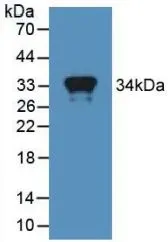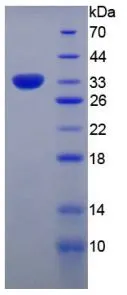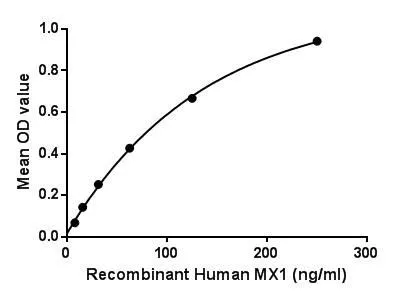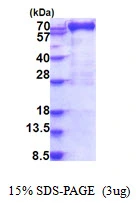
WB analysis of GTX00244-pro Human MX1 protein.
Human MX1 protein, His tag
GTX00244-PRO
ApplicationsFunctional Assay
Product group Proteins / Signaling Molecules
Protein IDP20591
Overview
- SupplierGeneTex
- Product NameHuman MX1 protein, His tag
- Delivery Days Customer9
- Application Supplier NoteInterferon-induced GTP-binding protein Mx1 is a protein that in humans is encoded by the MX1 gene. In mouse, the interferon-inducible Mx protein is responsible for a specific antiviral state against influenza virus infection. The protein encoded by this gene is similar to the mouse protein as determined by its antigenic relatedness, induction conditions, physicochemical properties, and amino acid analysis. This cytoplasmic protein is a member of both the dynamin family and the family of large GTPases. Besides, Tubulin Beta (TUBb) has been identified as an interactor of MX1, thus a binding ELISA assay was conducted to detect the interaction of recombinant human MX1 and recombinant human TUBb. Briefly, MX1 was diluted serially in PBS with 0.01% BSA (pH 7.4). Duplicate samples of 100 microl were then transferred to TUBb-coated microtiter wells and incubated for 2h at 37C. Wells were washed with PBST and incubated for 1h with anti-MX1 pAb, then aspirated and washed 3 times. After incubation with HRP labelled secondary antibody, wells were aspirated and washed 3 times. With the addition of substrate solution, wells were incubated 15-25 minutes at 37C. Finally, add 50 microl stop solution to the wells and read at 450nm immediately. The binding activity of MX1 and TUBb was in a dose dependent manner.
- ApplicationsFunctional Assay
- CertificationResearch Use Only
- ConjugateUnconjugated
- Protein IDP20591
- Protein NameInterferon-induced GTP-binding protein Mx1
- Scientific DescriptionThis gene encodes a guanosine triphosphate (GTP)-metabolizing protein that participates in the cellular antiviral response. The encoded protein is induced by type I and type II interferons and antagonizes the replication process of several different RNA and DNA viruses. There is a related gene located adjacent to this gene on chromosome 21, and there are multiple pseudogenes located in a cluster on chromosome 4. Alternative splicing results in multiple transcript variants. [provided by RefSeq, Sep 2013]
- Storage Instruction-20°C or -80°C,2°C to 8°C
- UNSPSC12352202



